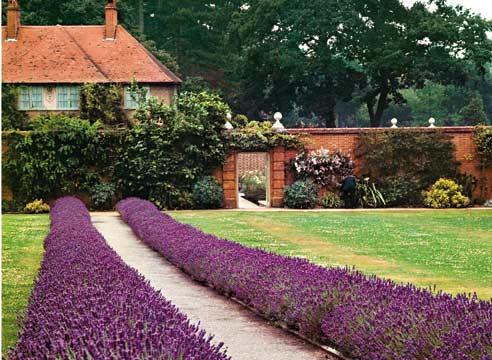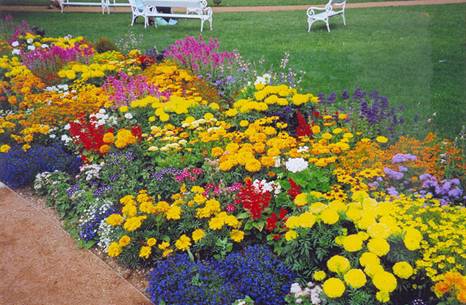With the development of private construction, the interest in the landscape decoration has significantly increased. The current areas near the house are not just a few planted bushes interspersed with flowers or a garden from favorite vegetables.
Content
For the most part, the green area is a carefully thought out project with a clear planning of even small nuances. For its design, various methods of natural decoration are used: it is the motley flower beds, and picturesque waterfalls, and park areas, and useful vegetable mixtures, and the Hills of the Alps in miniature, and bright green gentlemen of lawns with cultivated grass. Especially rich opportunities are opened in the formation of flower beds, among which the Rabatki uses with a wide demand.
What is a slatkat?
Rabatka - a special style of decorful flower beds in the form of a rectangle. The total length of such a flower garden is selected exclusively under a certain area. Despite the features of the form, the Rabata are often used in various parts of the green zone:
- for the framing tracks;
- as a separate flowerbed in the middle of the lawn;
- along the fences;
- as decoration of living hedges;
- throughout the perimeter of the site;
- to distinguish the lawn.

Important! Regardless of the location of the location, Klumba Rabatka always looks spectacular and attractive with a properly decorated structure.
Types of Rabatok
In order to allocate different types of flower beds of this type, several classification criteria are used:
- Plant type. Some flowerbeds are drawn up only for one season from annual plants, others are planned for several years exclusively from perennial species. Therefore, the type of flower beds is determined:
- Method of arrangement of colors. For this principle, two types of flower bed are distinguished:
- unilateral;
- bilateral.
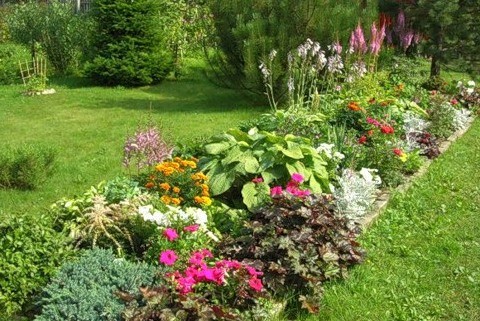
Important! The principle of differences is significant and requires a mandatory preliminary choice of the location of all flower beds. So, one-sided is more profitably equipped along the hedge, as it will be good to view the whole bouquet only on the one hand.
Two-sided interestingly look at the middle of the lawn or when the lawn is distinted. For the design of Rabata along the track, both methods are used, given the features of the entire landscape composition.

- Color spectrum. Depending on the number of basic colors used for the design of the Rabata flower bed, allocate:
- contrasting, the main principle of the formation of which is the alternation of several motion colors;

- monochrome, in which, with simultaneous flowering, no more than 3 main tones are formed, but with their different shades possible.

Important! Be careful and neat when selecting colors for contrasting Rabatka, overly carried away, it is possible to achieve the opposite impression of complete beamless, excessive varnishes and a common dissonance with repulsive effect.

- contrasting, the main principle of the formation of which is the alternation of several motion colors;
- Plant dimensions. This criterion is defining for planning the number of tiers. Distinguish the following types of flower beds:
- single-tier, in which all the flowers form one solid cover due to the same height;

- bunk, decorated or with a central higher part with a double-sided form or a sequential location of low-growing and high varieties on two separated areas with one-sided type;
- multi-tier used solely when arranged one-sided discounts from perennials, as the process is more complicated, requires considerable time of time and maximum accurate planning.
- single-tier, in which all the flowers form one solid cover due to the same height;
Important! Especially interesting bunk and multi-tiered compositions for creating a smooth transition to live swelling.
How to choose Flowers for Rabbit?
There is no unambiguous answer to the question of the choice of plants, given all the variety of flora species.
We allocate only some important recommendations that cannot be taken into account when planning the flower beds:
- Color palette. Rabatki from a combination of bright shades look more interesting. The main rule is the wider the palette used, the more simple landing forms. For example, the magnificent flowering of a large number of contrasting shades is better to lay stripes, and when using only several species in one gamma, complex bizarre geometric shapes are more profitable and effectively.
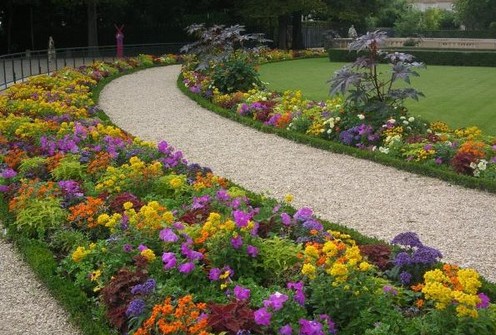
- Flowering period. Even with the arrangement of flower beds from annual species, be sure to consider the flowering period of the selected plants to eliminate the formation of voids or rapid flow of all Rabata due to the same lifetime of buds. It should not be a dissony contrast when changing the flowering of one species to others.
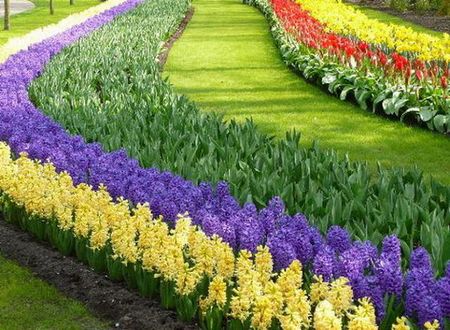
- Dimensions of adult plants. Be sure to focus on the location and form of future flower beds. It is especially true for bunk compositions in which incorrectly planted higher and lush plants did not overlap the miniature species that most often contribute to the unique attractiveness of the bright points of accents.

What types of colors are popular for decoration of slatas?
Despite the fact that there is no only advice on the choice of colors, will not be difficult to highlight the most popular species.
In a group of annual unchanging demand, such flowers are used:
The following varieties are allocated in the perennial line:
The decorativeness will be emphasized and refreshed by the Pestruk flower las in interesting shades of greenery:
- dwarf pine;
- juniper;
- dwarfice;
- decorative onions;
- feather grass;
- oatmeal;
- miscantus;
- canary;
- cortaeeria.

Important! Regardless of the purpose of the selected colors, avoid the use of aggressive species that will not only require more frequent leaving of the flower, but will also displace other species growing nearby.

Design principles
When creating the Rabata scheme, consider not only the rules of color. The conditions of the landing itself are equally important, so pay attention to the following necessary parameters of the future flower beds:
- The quality of the surface area. For this type of flower garden, smooth horizontal squares or gender slopes without irregularities are more suitable.

- Type of soil. Consider the characteristics of the soil to be confident that planted plants will be able to develop normally in favorable conditions for them. In addition, the availability of moisture depends on the composition of the soil, that is, based on these conditions, consider the future frequency of watering.

- Practicality. To ensure the constant attractiveness of the flower garden, a regular weeding is needed. Therefore, place all plants in such a way that there is free access to them. Too thick landing will not only make it difficult to courting the discount, but also the cause of the slowdown and defective development of colors.
Also pay attention to the clearer practical recommendations:
- Design the discreet width of at least 1m.
- The minimum length of the flower bed is equivalent to triple width.
- The maximum allowable number of plants on 1m2 is limited to 9 stranded or low-growing colors, 4 high species and 5 plants of medium height and pomp.
- Be sure to place the planting of flowers by shrubs after certain intervals. For long breakdowns, the most practical distance is 6 meters.

Examples of Rabatok schemes
How to arrange the discounts with your own hands?
To properly organize a flower leament, follow the next sequence of actions.
- Preview the photo of Rabatok to more clearly imagine the opportunity and choose the most interesting idea.

- Select the territory.
- Prepare a flower bed.
- Make the preliminary markup of the Rabatka with the help of pegs and rope.
- Treat the surface with weeds.
- Wait for breathing them.
- Remove all the dead weeds.
- Remove the top layer of soil to 15 cm deep.
- Redoil the remaining land for another 10 cm depth.
- Remove the soil mix with sand, peat and fertilizers in suitable soil type proportions.
- Put on the place of the future flower garden.
- Cross.
- Thoroughly paint the prepared soil of Rabatka.
- Wait a little shrinkage.
- Make marking for each group of plants on the flower bed.
- Determine the number of colors in each individual part.
- Place the flowers in the sequence corresponding to the project.

The whole process of design of Rabatka is not difficult and very interesting, but requires a lot of time and compliance with certain conditions. Take care carefully to the rules of design and combination of colors and the result obtained will certainly please you with your painting.






